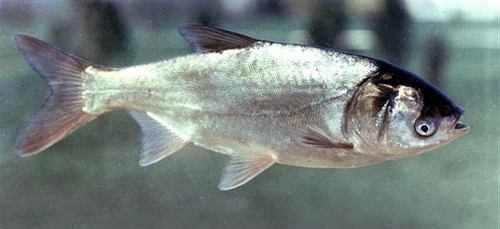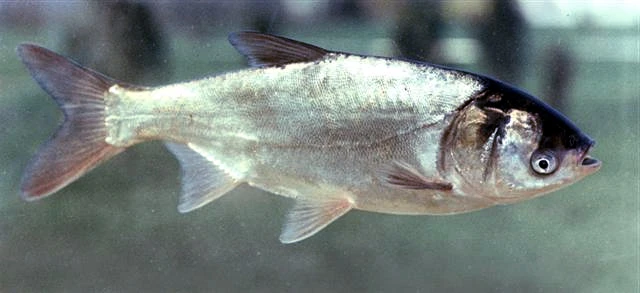Information
Version: B | 1.3 (2024-12-31)
- minor editorial changes plus new side note "Commercial relevance"
WelfareScore | farm
Condensed assessment of the species' likelihood and potential for good fish welfare in aquaculture, based on ethological findings for 10 crucial criteria.
- Li = Likelihood that the individuals of the species experience good welfare under minimal farming conditions
- Po = Potential of the individuals of the species to experience good welfare under high-standard farming conditions
- Ce = Certainty of our findings in Likelihood and Potential
WelfareScore = Sum of criteria scoring "High" (max. 10)
General remarks
Hypophthalmichthys molitrix is one of the four Chinese major carps, together with H. nobilis, Ctenopharyngodon idella, and Mylopharyngodon piceus. This freshwater BENTHOPELAGIC fish naturally occurs in river systems in China and Russia and has been introduced into many countries for aquaculture purposes, despite its apparent great invasion potential and low market price. Together with H. nobilis, it is one of the most intensively cultured fish species in Asia, which is commonly raised in a system of 'harvesting and stocking', that is, stocking at a high density, partial harvesting of the larger FISHES, and the addition of new fingerlings.
This Chinese carp, which prefers low flow but not stagnant waters, is commonly raised in polycultures in ponds, pens, reservoirs or lakes. As a plankton feeder, H. molitrix is frequently stocked in ponds for water quality enhancement and as a biocontrol method for phytoplankton. Competition with other species of similar feeding habits in polycultures is expected. H. molitrix is known for leaping out of the water when disturbed, and it naturally breeds during late spring and summer when the water level increases, migrating upstream to spawn. This carp is not able to spawn naturally in ponds or tanks, and its age and size at sexual maturity is apparently very variable and greatly affected by temperature, which means that it can be sold before reaching maturity. H. molitrix is usually kept alive from harvesting to marketing, as it is commonly consumed fresh, so that trucks and boats with water are frequently used as transportation tools. More studies about better slaughtering processes, stress response, and malformations on this species are needed, as well as studies about aggression both in wild and farm conditions. Furthermore, as most of the wild information comes from non-native waters research, more studies are still necessary in native waters.
1 Home range
Many species traverse in a limited horizontal space (even if just for a certain period of time per year); the home range may be described as a species' understanding of its environment (i.e., its cognitive map) for the most important resources it needs access to.
What is the probability of providing the species' whole home range in captivity?
It is low for minimal farming conditions. It is medium for high-standard farming conditions. Our conclusion is based on a medium amount of evidence.


2 Depth range
Given the availability of resources (food, shelter) or the need to avoid predators, species spend their time within a certain depth range.
What is the probability of providing the species' whole depth range in captivity?
It is low for minimal farming conditions. It is medium for high-standard farming conditions. Our conclusion is based on a medium amount of evidence.


3 Migration
Some species undergo seasonal changes of environments for different purposes (feeding, spawning, etc.), and to move there, they migrate for more or less extensive distances.
What is the probability of providing farming conditions that are compatible with the migrating or habitat-changing behaviour of the species?
It is low for minimal farming conditions. It is medium for high-standard farming conditions. Our conclusion is based on a medium amount of evidence.


4 Reproduction
A species reproduces at a certain age, season, and sex ratio and possibly involving courtship rituals.
What is the probability of the species reproducing naturally in captivity without manipulation of these circumstances?
It is low for minimal and high-standard farming conditions. Our conclusion is based on a high amount of evidence.


5 Aggregation
Species differ in the way they co-exist with conspecifics or other species from being solitary to aggregating unstructured, casually roaming in shoals or closely coordinating in schools of varying densities.
What is the probability of providing farming conditions that are compatible with the aggregation behaviour of the species?
It is low for minimal farming conditions. It is medium for high-standard farming conditions. Our conclusion is based on a medium amount of evidence.


6 Aggression
There is a range of adverse reactions in species, spanning from being relatively indifferent towards others to defending valuable resources (e.g., food, territory, mates) to actively attacking opponents.
What is the probability of the species being non-aggressive and non-territorial in captivity?
It is unclear for minimal and high-standard farming conditions. Our conclusion is based on a low amount of evidence.


7 Substrate
Depending on where in the water column the species lives, it differs in interacting with or relying on various substrates for feeding or covering purposes (e.g., plants, rocks and stones, sand and mud, turbidity).
What is the probability of providing the species' substrate and shelter needs in captivity?
It is low for minimal farming conditions. It is medium for high-standard farming conditions. Our conclusion is based on a medium amount of evidence.


8 Stress
Farming involves subjecting the species to diverse procedures (e.g., handling, air exposure, short-term confinement, short-term crowding, transport), sudden parameter changes or repeated disturbances (e.g., husbandry, size-grading).
What is the probability of the species not being stressed?
It is low for minimal farming conditions. It is medium for high-standard farming conditions. Our conclusion is based on a low amount of evidence.


9 Malformations
Deformities that – in contrast to diseases – are commonly irreversible may indicate sub-optimal rearing conditions (e.g., mechanical stress during hatching and rearing, environmental factors unless mentioned in crit. 3, aquatic pollutants, nutritional deficiencies) or a general incompatibility of the species with being farmed.
What is the probability of the species being malformed rarely?
It is unclear for minimal and high-standard farming conditions. Our conclusion is based on a low amount of evidence.


10 Slaughter
The cornerstone for a humane treatment is that slaughter a) immediately follows stunning (i.e., while the individual is unconscious), b) happens according to a clear and reproducible set of instructions verified under farming conditions, and c) avoids pain, suffering, and distress.
What is the probability of the species being slaughtered according to a humane slaughter protocol?
It is low for minimal farming conditions. It is high for high-standard farming conditions. Our conclusion is based on a low amount of evidence.


Side note: Domestication
Teletchea and Fontaine introduced 5 domestication levels illustrating how far species are from having their life cycle closed in captivity without wild input, how long they have been reared in captivity, and whether breeding programmes are in place.
What is the species’ domestication level?
DOMESTICATION LEVEL 539, fully domesticated.
Side note: Forage fish in the feed
450-1,000 milliard wild-caught fishes end up being processed into fish meal and fish oil each year which contributes to overfishing and represents enormous suffering. There is a broad range of feeding types within species reared in captivity.
To what degree may fish meal and fish oil based on forage fish be replaced by non-forage fishery components (e.g., poultry blood meal) or sustainable sources (e.g., soybean cake)?
All age classes: WILD: planktonic feeder, mainly on phytoplankton 404183215272023 but also on zooplankton 40322023 or detritus 183215, especially in more polluted environments 27. FARM: no additional feed in polyculture 18. Phytoplankton feeder 51113, but can also feed on zooplankton 1113 (FRY fed on zooplankton and later changed to phytoplankton 2), rarely organic detritus 5. JUVENILES did not accept artificial feed 5 which not affected growth 7 but improved survival in polycultures 7.
Side note: Commercial relevance
How much is this species farmed annually?
4,827,720 t/year 1990-2019 amounting to estimated 3,218,000,000-6,900,000,000 IND/year 1990-2019 41.
Glossary
BENTHOPELAGIC = living and feeding near the bottom of a body of water, floating above the floor
DOMESTICATION LEVEL 5 = selective breeding programmes are used focusing on specific goals 39
FARM = setting in farming environment or under conditions simulating farming environment in terms of size of facility or number of individuals
FISHES = using "fishes" instead of "fish" for more than one individual - whether of the same species or not - is inspired by Jonathan Balcombe who proposed this usage in his book "What a fish knows". By referring to a group as "fishes", we acknowledge the individuals with their personalities and needs instead of an anonymous mass of "fish".
FRY = larvae from external feeding on
IND = individuals
JUVENILES = fully developed but immature individuals
LAB = setting in laboratory environment
LARVAE = hatching to mouth opening
NTU = Nephelometric Turbidity Units
PHOTOPERIOD = duration of daylight
POTAMODROMOUS = migrating within fresh water
SPAWNERS = adults during the spawning season; in farms: adults that are kept as broodstock
WILD = setting in the wild
Bibliography
2 Wang, J. Q., S. A. Flickinger, K. Be, Y. Liu, and H. Xu. 1989. Daily food consumption and feeding rhythm of silver carp (Hypophthalmichthys molitrix) during fry to fingerling period. Aquaculture 83: 73–79. https://doi.org/10.1016/0044-8486(89)90061-6.
3 Green, B. W., and R. O. Smitherman. 1984. Relative growth, survival and harvestability of bighead carp, silver carp, and their reciprocal hybrids. Aquaculture 37: 87–95. https://doi.org/10.1016/0044-8486(84)90046-2.
4 Jhingran, V.G., and R.S.V. Pullin. 1985. A hatchery manual for the common, Chinese and Indian major carps. Vol. 252. ICLARM Studies and Reviews 11. Asian Development Bank and International Center for Living Aquatic Resources Management.
5 Cremer, M. C., and R. O. Smitherman. 1980. Food habits and growth of silver and bighead carp in cages and ponds. Aquaculture 20: 57–64. https://doi.org/10.1016/0044-8486(80)90061-7.
6 Lieberman, D. M. 1996. Use of Silver Carp (Hypophthalmichthys molotrix) and Bighead Carp (Aristichthys nobilis) for Algae Control in a Small Pond: Changes in Water Quality. Journal of Freshwater Ecology 11: 391–397. https://doi.org/10.1080/02705060.1996.9664466.
7 Abdelghany, A. E., and M. H. Ahmad. 2002. Effects of feeding rates on growth and production of Nile tilapia, common carp and silver carp polycultured in fertilized ponds. Aquaculture Research 33: 415–423. https://doi.org/10.1046/j.1365-2109.2002.00689.x.
8 Milstein, A., A. Kadir, and M. A. Wahab. 2008. The effects of partially substituting Indian carps or adding silver carp on polycultures including small indigenous fish species (SIS). Aquaculture 279: 92–98. https://doi.org/10.1016/j.aquaculture.2008.04.009.
9 Li, K., Z. Xu, Z. Liu, and B. Gu. 2013. Stable isotope enrichment, dietary sources and trophic overlap between silver carp (Hypophthalmichthys molitrix) and bighead carp (Aristichthys nobilis). Aquaculture 402–403: 8–12. https://doi.org/10.1016/j.aquaculture.2013.03.020.
10 Mahboob, S. 2014. Replacing Fish Meal With a Blend of Alternative Plant Proteins and its Effect on the Growth Performance of Catla catla and Hypophthalmichthys molitrix. Pakistan Journal of Zoology 747–752: 6.
11 Ke, Z., P. Xie, and L. Guo. 2008. In situ study on effect of food competition on diet shifts and growth of silver and bighead carps in large biomanipulation fish pens in Meiliang Bay, Lake Taihu. Journal of Applied Ichthyology 24: 263–268. https://doi.org/10.1111/j.1439-0426.2008.01060.x.
12 Gaigher, I. G., and J. B. Krause. 1983. Growth rates of Mozambique tilapia (Oreochromis mossambicus) and silver carp (Hypophthalmichthys molitrix) without artificial feeding in floating cages in plankton-rich waste water. Aquaculture 31: 361–367. https://doi.org/10.1016/0044-8486(83)90325-3.
13 Xiao, L., H. Ouyang, H. Li, M. Chen, Q. Lin, and B. Han. 2010. Enclosure Study on Phytoplankton Response to Stocking of Silver Carp (Hypophthalmichthys molitrix) in a Eutrophic Tropical Reservoir in South China. International Review of Hydrobiology 95: 428–439. https://doi.org/10.1002/iroh.201011249.
14 DeGrandchamp, K. L., J. E. Garvey, and R. E. Colombo. 2008. Movement and Habitat Selection by Invasive Asian Carps in a Large River. Transactions of the American Fisheries Society 137: 45–56. https://doi.org/10.1577/T06-116.1.
15 Calkins, H. A., S. J. Tripp, and J. E. Garvey. 2012. Linking silver carp habitat selection to flow and phytoplankton in the Mississippi River. Biological Invasions 14: 949–958. https://doi.org/10.1007/s10530-011-0128-2.
16 Brzuska, E. 1999. Artificial spawning of herbivorous fish: use of an LHRH-a to induce ovulation in grass carp Ctenopharyngodon idella (Valenciennes) and silver carp Hypophthalmichthys molitrix (Valenciennes). Aquaculture Research 30: 849–856. https://doi.org/10.1046/j.1365-2109.1999.00413.x.
17 Brandt, F. W., and H. J. Schoonbee. 1980. Further observations on the induced spawning of the phytophagous Chinese Carp Species Ctenopharyngodon idella (Val.) and Hypophthalmichthys molitrix (Val.). Water SA 6: 27–30.
18 Yang, N. 2021. Cultured Aquatic Species Information Programme. Hypophthalmichthys molitrix (Valenciennes, 1844). Rome: FAO Fisheries and Aquaculture Department. http://www.fao.org/fishery/culturedspecies/Hypophthalmichthys_molitrix/en. Accessed July 5.
19 Chick, J. H., C. E. Colaninno, A. M. Beyer, K. B. Brown, C. T. Dopson, A. O. Enzerink, S. R. Goesmann, et al. 2020. Following the edge of the flood: use of shallow-water habitat by larval silver carp Hypophthalmichthys molitrix in the upper Mississippi river system. Journal of Freshwater Ecology 35: 95–104. https://doi.org/10.1080/02705060.2020.1742809.
20 Yu, J., J. Chen, X. Deng, Z. Wu, Z. Yu, J. Xu, H. Su, et al. 2019. Trophic Patterns of Bighead Carp and Silver Carp Follow the Seasonality of Resource Availability. Water 11: 1429. https://doi.org/10.3390/w11071429.
21 Prechtel, A. R., A. A. Coulter, L. Etchison, P. R. Jackson, and R. R. Goforth. 2018. Range estimates and habitat use of invasive Silver Carp (Hypophthalmichthys molitrix): Evidence of sedentary and mobile individuals. Hydrobiologia 805: 203–218. https://doi.org/10.1007/s10750-017-3296-y.
22 Ridgway, J. L., J. M. Goeckler, J. Morris, and J. J. Hammen. 2020. Diel Influences on Silver Carp Catch Rates Using an Electrified Paupier in Lentic Habitats. North American Journal of Fisheries Management 40: 1023–1031. https://doi.org/10.1002/nafm.10467.
23 Zhang, M., Y. Wang, B. Gu, Y. Li, W. Zhu, L. Zhang, L. Yang, and X. Li. 2019. Resources utilization and trophic niche between silver carp and bighead carp in two mesotrophic deep reservoirs. Journal of Freshwater Ecology 34: 199–212. https://doi.org/10.1080/02705060.2018.1560368.
24 Hintz, W. D., D. C. Glover, B. C. Szynkowski, and J. E. Garvey. 2017. Spatiotemporal Reproduction and Larval Habitat Associations of Nonnative Silver Carp and Bighead Carp. Transactions of the American Fisheries Society 146: 422–431. https://doi.org/10.1080/00028487.2017.1281167.
25 Coulter, A. A., E. J. Bailey, D. Keller, and R. R. Goforth. 2016. Invasive Silver Carp movement patterns in the predominantly free-flowing Wabash River (Indiana, USA). Biological Invasions 18: 471–485. https://doi.org/10.1007/s10530-015-1020-2.
26 Xie, P., and Y. Yang. 2000. Long-term changes of Copepoda community (1957–1996) in a subtropical Chinese lake stocked densely with planktivorous filter-feeding silver and bighead carp. Journal of Plankton Research 22: 1757–1778. https://doi.org/10.1093/plankt/22.9.1757.
27 Jayasinghe, U. A. D., E. García-Berthou, Z. Li, W. Li, T. Zhang, and J. Liu. 2015. Co-occurring bighead and silver carps show similar food preference but different isotopic niche overlap in different lakes. Environmental Biology of Fishes 98: 1185–1199. https://doi.org/10.1007/s10641-014-0351-7.
28 Liss, S. A., G. G. Sass, and C. D. Suski. 2014. Influence of local-scale abiotic and biotic factors on stress and nutrition in invasive silver carp. Hydrobiologia 736: 1–15. https://doi.org/10.1007/s10750-014-1880-y.
29 Papoulias, D. M., D. Chapman, and D. E. Tillitt. 2006. Reproductive condition and occurrence of intersex in bighead carp and silver carp in the Missouri River. Hydrobiologia 571: 355–360. https://doi.org/10.1007/s10750-006-0260-7.
30 Liss, S. A., G. G. Sass, and C. D. Suski. 2013. Spatial and temporal influences on the physiological condition of invasive silver carp. Conservation Physiology 1. https://doi.org/10.1093/conphys/cot017.
31 Froese, R., and D. Pauly. 2021. Hypophthalmichthys molitrix, Silver carp: fisheries, aquaculture. World Wide Web electronic publication. FishBase. https://www.fishbase.de/summary/Hypophthalmichthys-molitrix.html. Accessed July 8.
32 Williamson, C. J., and J. E. Garvey. 2005. Growth, Fecundity, and Diets of Newly Established Silver Carp in the Middle Mississippi River. Transactions of the American Fisheries Society 134: 1423–1430. https://doi.org/10.1577/T04-106.1.
33 Varghese, T. J., and G.P. S. Rao. 1976. Induced spawning of the Chinese silver carp, Hypophthalmichthys molitrix (C. and V.) and the Indian major carp, Catla catla (Ham.) using marine catfish pituitary extract. In , 417–419. Colombo, Sri Lanka.
34 Schoonbee, H. J., and J. F. Prinsloo. 1984. Techniques and hatchery procedures in induced spawning of the European common carp, Cyprinus carpio and the Chinese carps Ctenopharyngodon idella, Hypophthalmichthys molitrix and Aristichthys nobilis in Transkei. Water SA 10: 36–39. https://doi.org/10.10520/AJA03784738_1275.
35 Hasan, M., and A. N. Bart. 2007. Improved survival of rohu, Labeo rohita (Hamilton-Buchanan) and silver carp, Hypophthalmichthys molitrix (Valenciennes) fingerlings using low-dose quinaldine and benzocaine during transport. Aquaculture Research 38: 50–58. https://doi.org/10.1111/j.1365-2109.2006.01628.x.
36 Ghosal, R., P. X. Xiong, and P. W. Sorensen. 2016. Invasive Bighead and Silver Carps Form Different Sized Shoals that Readily Intermix. PLOS ONE 11: e0157174. https://doi.org/10.1371/journal.pone.0157174.
37 Zhang, L., Q. Li, J. Lyu, C. Kong, S. Song, and Y. Luo. 2016. The impact of stunning methods on stress conditions and quality of silver carp (Hypophthalmichthys molitrix) fillets stored at 4°C during 72h postmortem. Food chemistry 216: 130–137. https://doi.org/10.1016/j.foodchem.2016.08.004.
38 Zhang, L., Y. Zhang, S. Jia, Y. Li, Q. Li, K. Li, H. Hong, and Y. Luo. 2019. Stunning stress-induced textural softening in silver carp (Hypophthalmichthys molitrix) fillets and underlying mechanisms. Food Chemistry 295: 520–529. https://doi.org/10.1016/j.foodchem.2019.05.148.
39 Teletchea, Fabrice, and Pascal Fontaine. 2012. Levels of domestication in fish: implications for the sustainable future of aquaculture. Fish and Fisheries 15: 181–195. https://doi.org/10.1111/faf.12006.
40 Spataru, P., and M. Gophen. 1985. Feeding behaviour of silver carp Hypophthalmichthys molitrix Val. and its impact on the food web in Lake Kinneret, Israel. Hydrobiologia 120: 53–61. https://doi.org/10.1007/BF00034590.
41 Mood, Alison, Elena Lara, Natasha K. Boyland, and Phil Brooke. 2023. Estimating global numbers of farmed fishes killed for food annually from 1990 to 2019. Animal Welfare 32: e12. https://doi.org/10.1017/awf.2023.4.







